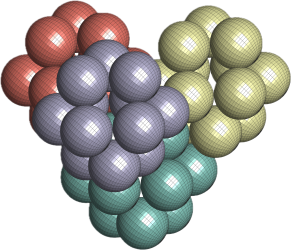Slides: CMOpresentation.pdf
Plane group packings with regular pentagons
First experiments with packing pentagons using plane groups. Genetic algorithm was used to optimize the packing density. It seems that the optimal packing density is approx. 0.92 ( Packings of Regular Pentagons in the Plane ).
2. Plane group: p2
Density: 0.8550
3. Plane group: pm
Density: 0.6798
4. Plane group: pg
Density: 0.8879
5. Plane group: cm
Density: 0.7450
6. Plane group: p2mm
Density: 0.6930
7. Plane group: p2mg
Density: 0.8539
8. Plane group: p2gg
Density: 0.9104
9. Plane group: c2mm
Density: 0.6908
10. Plane group: p4
Density: 0.8423
11. Plane group: p4mm
Density: 0.5406
12. Plane group: p4gm
Density: 0.6957
13. Plane group: p3
Density: 0.8578
14. Plane group: p3m1
Density: 0.5236
15. Plane group: p31m
Density: 0.6980
16. Plane group: p6
Density: 0.7290
17. Plane group: p6mm
Density: 0.4914
IPAP presentation v2.0
Slides: miloPresentation.pdf
End of year presentation
Slides: endOfYearPresentation.pdf
Combinatorial packing
Starting to experiment with combinatorial packings by gluing particles together along their edges and finding a configuration with maximal ratio between the volume of the sum of the particles and the volume of the convex hull of the particles. Here are some examples.
ratio = 0.4500
Expanding the tree to two particles. There are only two admissible configurations with different ratios for two particles.
1. branch
ratio = 0.4
Ratios from left to right: 0.3857, 0.4045, 04075, 0.4372, 0.4015, 0.3724
2. branch
ratio = 0.4091
Ratios from left to right: 0.4045, 0.3971, 0.3803, 0.4075, 0.4372, 0.4015
First year report
Just to have everything in one place.
Packing pentacene continued
I modified the original algorithm to work better. It’s significantly slower but I get better results. There seems to be a relationship between number of objects in the unit cell and the algorithm’s performance. The more shapes the worse density. (more local minima on the landscape?). The other thing is packings are physically unrealistic, that is the shapes from different unit cells are intertwined. No more problem is that the density did go higher then 1 which should not be. Maybe we need a more suitable formula for computing density in the periodic setting.
Results
1 pentacene model in a unit cell
Density = 1.9932
2 pentacene models in a unit cell
Density = 1.0063
4 pentacene models in a unit cell
Density = 0.8093
8 pentacene models in a unit cell
Density = 0.6940
54 pentacene models in a unit cell
Density = 0.1788
Pentacene packing
I got to packing Pentacene model based on previous computations. see http://milotorda.net/index.php/pentacene-modeling/ . From the coordinates of the atoms of the Pentacene molecule
I have created a point cloud by placing 14 points around every atom in the Pentacene uniformly placed on a sphere with radius 0.5573/2.
and finally taken the convex hull of the point cloud as the 3D-model of Pentacene. The resulting structure is in the form of triangulation with 58 vertices, 112 edges and 168 faces. Volume of the polyhedron is 48.237.
Subsequently I used the Torquato – Jiao packing algorithm to create packings of various numbers of pentacene models in a unit cell.
4 pentacene models in a unit cell
Initial configuration
Density = 0.0037.
Original algorithm
First iteration
Density = 0.0291
Second iteration
Density = 0.0512
simulated annealing
First iteration
Density = 0.0514
Second iteration
Density = 0.1178
8 pentacene models in a unit cell
initial configuration
Density = 0.0075
Original algorithm
First iteration
Density = 0.0660
Second iteration
Density = 0.0436
simulated annealing
First iteration
Density = 0.0234
Packing triangles with fmincon()
I experimented with the packing of triangles using previous model and Matlab’s fmincon() optimizer. For each setting 100 runs were performed with the following initial conditions. Triangles have the same initial positions in the initial unit cell with random rotations. The algorithm used was interior point with supplied objective gradient.
3 triangle setting
Out of 100 runs 45 resulted in feasible solutions. 40 with exitflag== -2, 0 with exitflag== -1, 21 with exitflag== 0., 0 with exitflag== 1, 39 with exitflag== 2. Mean density in the feasible solution cases was 0.5827 and variance 0.0197. The best case had density 0.8118.
Left is the initial setup and right is the best found solution.
4 triangle setting
Out of 100 runs 20 resulted in feasible solutions. 66 with exitflag== -2, 0 with exitflag== -1, 14 with exitflag== 0., 0 with exitflag== 1, 20 with exitflag== 2. Mean density in the feasible solution cases was 0.5850 and variance 0.0127. The best case had density 0.7959.
Left is the initial setup and right is the best found solution.
5 triangle setting
Out of 100 runs 9 resulted in feasible solutions. 71 with exitflag== -2, 0 with exitflag== -1, 20 with exitflag== 0., 0 with exitflag== 1, 9 with exitflag== 2. Mean density in the feasible solution cases was 0.5637 and variance 0.0111. The best case had density 0.7246.
Left is the initial setup and right is the best found solution.
4 triangle setting and GA
I did similiar thing with the GA algorithm. Out of 49 runs 19 resulted in feasible solutions. Mean density in the feasible solution cases was 0.7667 and variance 0.0115. The best case had density 0.9230.
Genetic algorithm applied to packing model
I used matlab global optimization toolbox’s genetic algorithm to solve the triangle packing problem outlined in previous post. It does what it is supposed to do :). i.e finds a tiling.
Left output of the GA algorithm. Optimal packing of two congruent triangles (red) and unit cell (blue). On the right are surrounding unit cells added.
Same but with 3 triangles in a unit cell. Doesn’t work so well. Takes 194 sec to compute. Density is 0.7178.
4 triangles. Took 138.315 sec to compute. Density is 0.6715;
5 triangles took 829.64 sec to compute. Density is 0.8055.
6 triangles took 228.458 sec to compute. Density is 0.7534.














































































